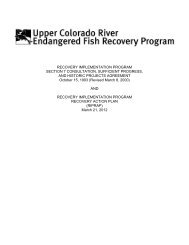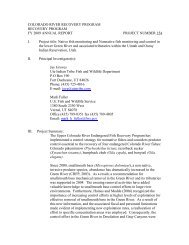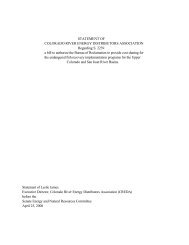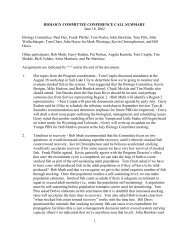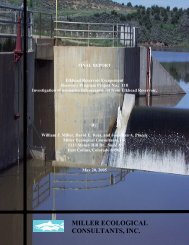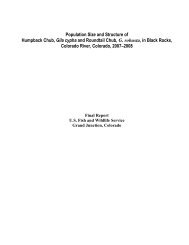K. R. Bestgen, K. A. Zelasko, and G. C. White. Monitoring ...
K. R. Bestgen, K. A. Zelasko, and G. C. White. Monitoring ...
K. R. Bestgen, K. A. Zelasko, and G. C. White. Monitoring ...
Create successful ePaper yourself
Turn your PDF publications into a flip-book with our unique Google optimized e-Paper software.
larvae (9–13 mm TL) suggested relatively late spawning in a location where razorback sucker<br />
was not common in recent years (KRB, unpublished data).<br />
In the middle Green River, a set of sites that are regularly available for sampling even<br />
when flows are extremely high or low are sampled each year. These include Cliff Creek, Stewart<br />
Lake Outlet, Old Charley Wash inlet or outlet, <strong>and</strong> Greasewood Corral. Those sites reliably<br />
provide first-capture-of-the-year information across the longitudinal extent of the middle Green<br />
River, especially at Cliff Creek, which is just downstream of known spawning areas (Hedrick et<br />
al. 2009; 2010; <strong>Bestgen</strong> et al. 2011). That site is especially important given the emphasis on<br />
using real-time information to dictate timing of annual releases from Flaming Gorge Dam, which<br />
are used to provide access of larvae to floodplain wetl<strong>and</strong>s. Several other sites are added<br />
annually based on availability of habitat including Baeser Wash, Walker Hollow, <strong>and</strong> other sites<br />
near or in Ouray National Wildlife Refuge. Those sites provide additional information on<br />
spawning success of adult razorback suckers <strong>and</strong> may also indicate presence <strong>and</strong> abundance of<br />
larvae in the vicinity of floodplain wetl<strong>and</strong> breaches. That information may be critical to<br />
underst<strong>and</strong>ing efficacy of various wetl<strong>and</strong> types to entrain razorback sucker larvae to enhance<br />
recruitment, information which is in turn important in experiments to underst<strong>and</strong> timing <strong>and</strong><br />
duration of flow events needed to effect recruitment of razorback suckers in floodplain wetl<strong>and</strong>s<br />
in the middle Green River. Sampling in or near entrances to floodplain wetl<strong>and</strong>s is a key<br />
component of the Larval Trigger Study Plan (LaGory et al. 2012), which describes a sampling<br />
program <strong>and</strong> approach to evaluate efficacy of using first appearance of sucker larvae to initiate<br />
higher flow releases in spring-time from Flaming Gorge Dam.<br />
We recommend continuation of the existing program of light trap sampling for early life<br />
history stage of razorback sucker in the middle Green River. Especially important is early<br />
monitoring of upstream sites at Cliff Creek <strong>and</strong> Stewart Lake to ascertain presence of native<br />
sucker larvae in the middle Green River to trigger spring flow releases from Flaming Gorge Dam<br />
in spring. We are confident that those sites <strong>and</strong> others will provide that information accurately.<br />
We base those assertions on recaptures of marked razorback sucker larvae released in the Green<br />
River in differing batch sizes <strong>and</strong> under different flow regimes (Hedrick et al. 2009; 2010;<br />
<strong>Bestgen</strong> et al. 2011). Even with relatively small batches of larvae (2004), or under relatively<br />
high flows (2005), sampling with light traps at various sentinel stations detected marked larvae<br />
within 18 to 48 hours of release, <strong>and</strong> as much as 90 km downstream from release sites.<br />
Nevertheless, because of the importance of detection of reproduction by native suckers with light<br />
12




